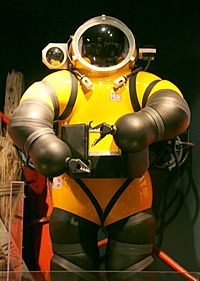Deep diving facts for kids
Deep diving means diving far down into the ocean. Divers use special gear to breathe underwater. This gear might be tanks of air on their backs, or a hose that sends breathing gas from a boat above. This lets them explore the deeper parts of the ocean.
Some divers, like those who work underwater, use special gas mixes. They might even wear strong, armored diving suits. These suits keep them safe from the high pressure deep down. A dive is usually called "deep" if it goes below about 30 meters (100 feet). Divers can stay underwater for a long time. They might work on oil wells or pipelines. They also explore sunken ships to find treasures or help bring the ships up.
One big danger of deep diving is called decompression sickness. This can happen if divers come up to the surface too fast. Because of this, people who dive for fun need special training. They must be certified to dive safely to certain depths.
Contents
What is Deep Diving?
Deep diving is a type of underwater diving. It takes divers much deeper than regular recreational dives. It needs special training, equipment, and safety rules. This is because the pressure underwater increases a lot as you go deeper.
Why Do People Deep Dive?
People deep dive for many reasons. Some are for work, and some are for adventure.
- Commercial diving: These divers work on underwater structures. They might build or fix oil rigs and pipelines. They also inspect bridges or clean ship hulls.
- Scientific research: Scientists deep dive to study marine life. They explore deep-sea environments. This helps us learn about new animals and plants.
- Exploration: Some divers explore underwater caves or shipwrecks. They look for lost artifacts or map unknown areas.
- Military operations: Navies use deep diving for special missions. This includes rescue operations or underwater repairs.
Special Equipment for Deep Diving
Diving deep means facing very high pressure. Divers need special gear to stay safe and breathe.
Breathing Gas Mixtures
Regular air is mostly nitrogen and oxygen. But for deep dives, divers use different gas mixes.
- Heliox: This mix uses helium and oxygen. Helium is used instead of nitrogen. Nitrogen can cause problems like "nitrogen narcosis" at deep depths. This makes divers feel dizzy or confused.
- Trimix: This mix has helium, oxygen, and nitrogen. The amount of each gas is carefully chosen. This helps divers avoid narcosis and other issues.
Armored Diving Suits
For very deep dives, divers might wear armored suits. These suits are like small submarines for one person.
- They keep the diver at normal surface pressure. This means the diver does not feel the high pressure of the deep ocean.
- These suits protect divers from cold water. They also protect from dangerous marine life.
- Divers can stay underwater for many hours in these suits. They use robotic arms to do work.
Dangers of Deep Diving
Deep diving is exciting but has serious risks. Divers must follow strict safety rules.
Decompression Sickness
This is also known as "the bends." It happens when divers come up too fast.
- Gases like nitrogen dissolve in a diver's blood under high pressure.
- If the pressure drops too quickly, these gases form bubbles.
- These bubbles can block blood flow. They can cause pain in joints and muscles.
- In serious cases, it can harm the brain or spinal cord. This can lead to paralysis or even death.
- To prevent this, divers make slow stops on their way up. These are called "decompression stops." This lets the gases leave their body safely.
High Pressure Nervous Syndrome (HPNS)
This can happen when divers go extremely deep, especially with helium mixes.
- Symptoms include tremors, dizziness, and confusion.
- Scientists are still studying why this happens. It is linked to the very high pressure.
Training and Certification
Becoming a deep diver takes a lot of training. Divers must learn about physics, physiology, and safety.
- They learn how to plan dives carefully. This includes calculating gas mixes and decompression stops.
- They practice emergency procedures. This prepares them for unexpected problems.
- Recreational divers need special certifications for deep dives. Commercial and scientific divers need even more advanced training.
Images for kids
-
Scuba diver using a rebreather with open circuit bailout cylinders returning from a 600-foot (180 m) dive
-
Technical divers preparing for a mixed-gas decompression dive in Bohol, Philippines. Note the backplate and wing setup with side mounted stage tanks containing EAN50 (left side) and pure oxygen (right side).
See also
 In Spanish: Buceo profundo para niños
In Spanish: Buceo profundo para niños




